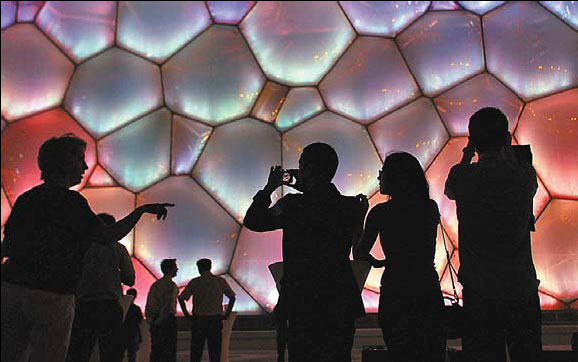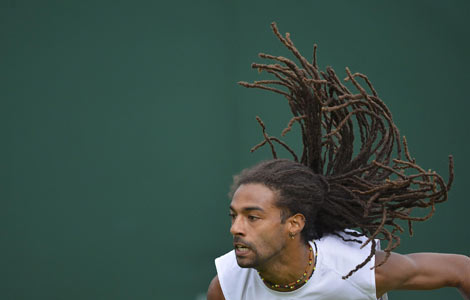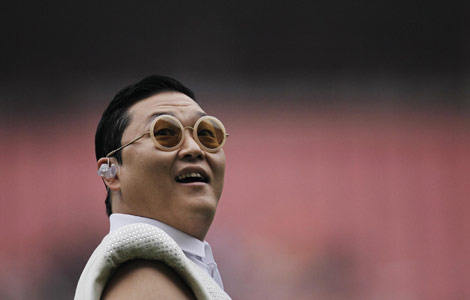In the mood
Updated: 2013-06-25 07:42
By Chen Nan (China Daily)
|
||||||||
|
The Water Cube attracts visitors at night with its new color scheme designed by artist Ma Wen. Zou Hong / China Daily |
The Water Cube moved away from it's standard hue of ocean blue over the weekend and instead started to display a variety of colors that reflect the mood of Beijing as part of an ambitious new art project.
The building's facade, illuminated by a fluid LED light, will start to change its colors daily in accordance with teachings of I Ching and emotional data collected from Chinese micro-blogging websites. The 2008 Olympic venue will now act as Beijing mood ring - with the building reflecting different light, color, composition, rhythm and movement based on the city's "emotion".
The light installation is the brainchild of Beijing-born and New York-based artist Ma Wen.
Ma says she was initially invited to design a 10-minute light show for the National Aquatics Center, better known as the Water Cube. But she refused.
"I believe many artists want to do it because the venue is world-renowned. But I don't want to simply change the skin of the iconic building. After 10 minutes of a dazzling show, it's still the same," Ma says.
She says she has a special connection with the building and she wants to do more with it.
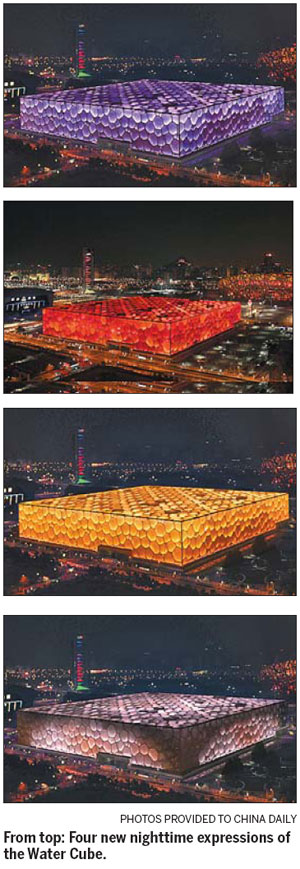
Ma was a member of the core creative team of the Beijing Olympic Opening Ceremony and its chief designer of visual and special effects.
While working on preparations for the opening ceremony, she saw the Water Cube every day and was impressed by the bubbling exterior.
"It's the fifth anniversary of the Water Cube since it was inaugurated during the 2008 Olympics. I want to do something for it and for the people living in the city and passing by it every day," Ma says.
"A real public artwork is not something that stands alone. It should interact with the people."
She presented a proposal to the company running the Water Cube after the Olympic Games to turn it into a permanent conceptual light installation, Nature and Man in Rhapsody of Light at the Water Cube, based on her years of research on China's philosophical classic I Ching.
Like many Chinese, Ma says she first knew of I Ching as a guidebook for how to live daily life using 64 hexagrams, which dictate everything from when you should get a haircut to the best day to move into a new house or break ground on a construction project.
Ma did not take I Ching too seriously. Like many people she put it in the same category as feng shui, believing it is silly superstition. But after conducting deeper research, she realized there was much more to I Ching.
"For centuries, the Chinese have consulted I Ching both as an oracle and as a means of self-understanding and understanding the universe," Ma says. "It has its own system of everything, such as nature, color and directions. I thought: 'Why not use I Ching for the Water Cube project?'"
Using light to express an abstract philosophy was a fascinating challenge for Ma. She has consulted I Ching teachers and read books to understand the traditional Chinese philosophy.
The first thing she did was sort different colors to express varied expressions based on I Ching teachings. She then worked with experts from the United States on changing the system into a RGB color code, in which red, green and blue lights are blended in various ways to reproduce a broad array of colors.
With the help of "emotion experts", the team collects the daily flow of the emotions of society, based on netizens' chatter on micro-blogging website Sina Weibo.
According to Ma, her team collects emotion data every day until 2 pm. After three to four hours of analyses and consultations with the I Ching color code, the computer program conveys the changing emotions of Beijing via lights on the Water Cube at night.
"The most exciting part of the artwork is that it will serve as an abstract aesthetic expression of China's ancient wisdom as expressed through collaboration of art and technology. Injecting netizens' emotional data into the work allows the individual to become a part of the artwork and effect change to this landmark structure," Ma says.
Zheng Jianwei, the chief designer for the lighting of the Olympic Green and the lighting consultant for the Bird's Nest stadium, worked with Ma on the Water Cube project. He was the first Chinese designer to win the world's most prestigious outdoor lighting design award, the Paul Waterbury Award of Excellence, in 2009 for his work at the 2008 Beijing Olympic Games.
"Lighting is not just for entertainment or for beautiful visual enjoyment. It reflects the emotions of people so the lighting could be beautiful or ugly. The installation is just like a thermometer of the city," he says.
For Ma, who is about to celebrate her 40th birthday, the Water Cube project is significant for her as an artist.
Since moving to New York in 1986, she has been experimenting with various media - installation, video, drawing, fashion design, performance and public art. As the main liaison between the international broadcast teams, she won an Emmy for the US broadcast of the Beijing Olympics Opening Ceremony.
"In the past, I kept myself busy to prove I am successful. I traveled every week to work and my suitcase was never unpacked. I was self-centered and aggressive about my work," she says.
"But now, with the Water Cube project, I learned to balance myself, and I think that it's the first time for me to give back to the public as an artist."

 'Taken 2' grabs movie box office crown
'Taken 2' grabs movie box office crown
 Rihanna's 'Diamonds' tops UK pop chart
Rihanna's 'Diamonds' tops UK pop chart
 Fans get look at vintage Rolling Stones
Fans get look at vintage Rolling Stones
 Celebrities attend Power of Women event
Celebrities attend Power of Women event
 Ang Lee breaks 'every rule' to make unlikely new Life of Pi film
Ang Lee breaks 'every rule' to make unlikely new Life of Pi film
 Rihanna almost thrown out of nightclub
Rihanna almost thrown out of nightclub
 'Dark Knight' wins weekend box office
'Dark Knight' wins weekend box office
 'Total Recall' stars gather in Beverly Hills
'Total Recall' stars gather in Beverly Hills
Most Viewed
Editor's Picks

|

|
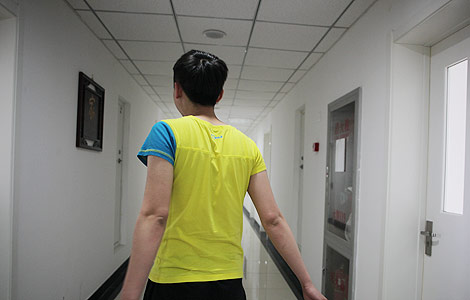
|

|

|

|
Today's Top News
Gerui CFO seeks to form bond with investors
Green goals set for Beijing and nearby areas
Astronauts leave Tiangong-1 space module
China shares extend losses, sink to new lows
Berlusconi convicted on sex charges
US presses Russia over Snowden
Emerging markets still react to Fed
Xi: 'Exploration part of Chinese dream'
US Weekly

|

|
